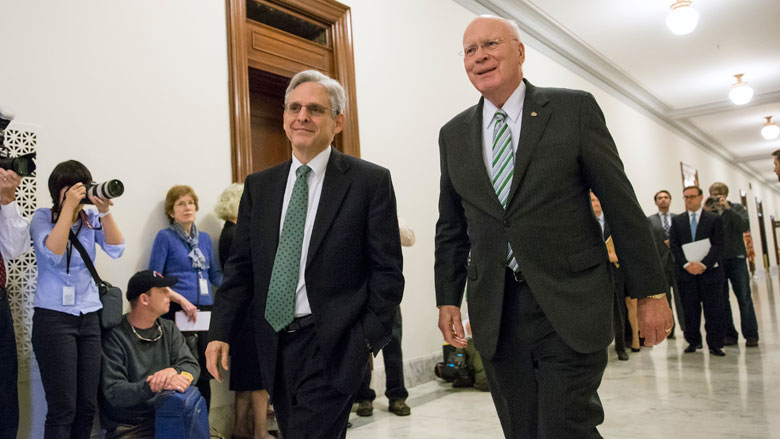Five truths about Senate confirmation of Supreme Court nominees
By Nathaniel Bruno and Jordan Lorence | March 18, 2016, 6:24 EDT
 Sen. Patrick Leahy, D-Vt., right, the top Democrat on the Senate Judiciary Committee walks with Judge Merrick Garland, President Barack Obama’s choice to replace the late Justice Antonin Scalia on the Supreme Court, on Capitol Hill in Washington, Thursday, March 17, 2016. (AP Photo/J. Scott Applewhite)
Sen. Patrick Leahy, D-Vt., right, the top Democrat on the Senate Judiciary Committee walks with Judge Merrick Garland, President Barack Obama’s choice to replace the late Justice Antonin Scalia on the Supreme Court, on Capitol Hill in Washington, Thursday, March 17, 2016. (AP Photo/J. Scott Applewhite) The U.S. Senate should wait until after the presidential election to fill the vacancy created by the death of U.S. Supreme Court Justice Antonin Scalia. These five truths should govern the process going forward.
The Senate Has No Duty to Act on the President’s Nominations
Although the president has the authority to nominate someone to the Supreme Court, nothing in the Constitution requires the Senate to take any particular action in any particular timeframe on that nominee. Article II, Section 2 of the Constitution provides that the president “shall nominate, and by and with the Advice and Consent of the Senate, shall appoint … Judges of the [S]upreme Court … .” Federalist Paper 67 makes it clear that the president and the Senate jointly hold the appointment power, which is distinct from the power to nominate. This means the Senate is free to exercise its own power as it sees fit, to approve or reject a nominee, or not to act upon a nomination.
The Senate Has a Tradition of Deliberate Inaction on Nominations
American history demonstrates numerous times the Senate’s prerogative to decline to take action on nominees for federal office. For example, between 1987 and1996, a total of 154 presidential nominees for judicial and other senior federal government positions failed because the Senate held no hearings on those nominations. Records from the Congressional Research Service show that among the people officially nominated to serve on the Supreme Court, at least eight of them (5 percent) have failed to achieve confirmation as a result of postponement or inaction by the Senate.
The Supreme Court Can Function with Eight Justices
Frequently in the past, the Supreme Court has operated for months with eight justices and a vacant seat. The Supreme Court did not grind to a halt. The Supreme Court functioned during the 391-day period between Justice Abe Fortas resigning on May 14, 1969, and Justice Harry Blackmun being seated on June 9, 1970, following the Senate’s rejection of President Richard Nixon’s two prior nominees. The Supreme Court also operated during the 237-day period between the retirement of Justice Lewis Powell on June 26, 1987, and the seating of Justice Anthony Kennedy on February 18, 1988, after (among other things) the Senate rejected President Ronald Reagan’s prior nomination of Robert Bork.
The Supreme Court can conduct its business with eight justices because most of its decisions generally have majorities of more than five justices. If a case ties 4-4, the Court historically will hold the case for reargument when the ninth justice comes onto the bench. That happened when the Court waited for the Senate to confirm the nominations of Justices Kennedy, Thomas, and Alito.
Confirming a New Justice under the Current Circumstances Would Be Unprecedented
It is rare for the Senate to confirm a Supreme Court justice when a divided government exists during a president’s final year in office. Not since 1888 has a Supreme Court seat vacated in a presidential election year been filled by an opposition-partycontrolled Senate when the president is in the final year of his term.
The People Installed a Republican Senate to Counter the Democrat President
The American voters in 2014 elected a Republican majority to the Senate, which creates a divided government that places an additional check on the authority of President Obama. The voters may have done so because of President Obama’s repeated expansive use of executive power.
For instance, President Obama has: 1) unilaterally taken unconstitutional executive action instead of securing the passage of his policy initiatives through legislative means, including ones regarding immigration and gun control; 2) refused to “faithfully execute” the laws by engaging in selective non-enforcement of existing immigration law (with the Supreme Court soon to consider that very question in a case to be heard in April 2016); 3) through the Department of Health and Human Services, promulgated an Obamacare mandate that requires employers to offer health insurance plans that cover contraception and abortion-inducing drugs in violation of the religious beliefs of many employers (which the Supreme Court held unlawful in 2014 as to closely-held private corporations and will review again in a consolidated appeal of cases involving religious non-profits in March 2016); and 4) made improper recess appointments to the National Labor Relations Board, which all nine Supreme Court justices declared unconstitutional in the 2014 Noel Canning decision.
Even if one concludes that the Senate Republicans see their mandate from the voters too broadly, it is the current political reality, which the voters will be able to confirm or reject at the ballot box this November. The newly elected president and senators will then be informed as nearly as possible by the full, fresh, well-considered vote of the people, who will grasp the significance of the stakes in play with respect to the vacant Supreme Court seat and will communicate their collective will through whom they elect.
All of this context makes it eminently reasonable for prudent senators to exercise their clear constitutional authority to wait for the voters to weigh in, and not permit President Obama—on his way out of office—to select a Supreme Court justice who will affect the trajectory of the Court’s jurisprudence for decades to come.
Nathaniel Bruno and Jordan Lorence are senior counsels with Alliance Defending Freedom.










